If you're looking for an affordable, easy, delicious family meal that can be cooked in a single pot, this slow-cooked beef ragu linguine is the recipe for you.
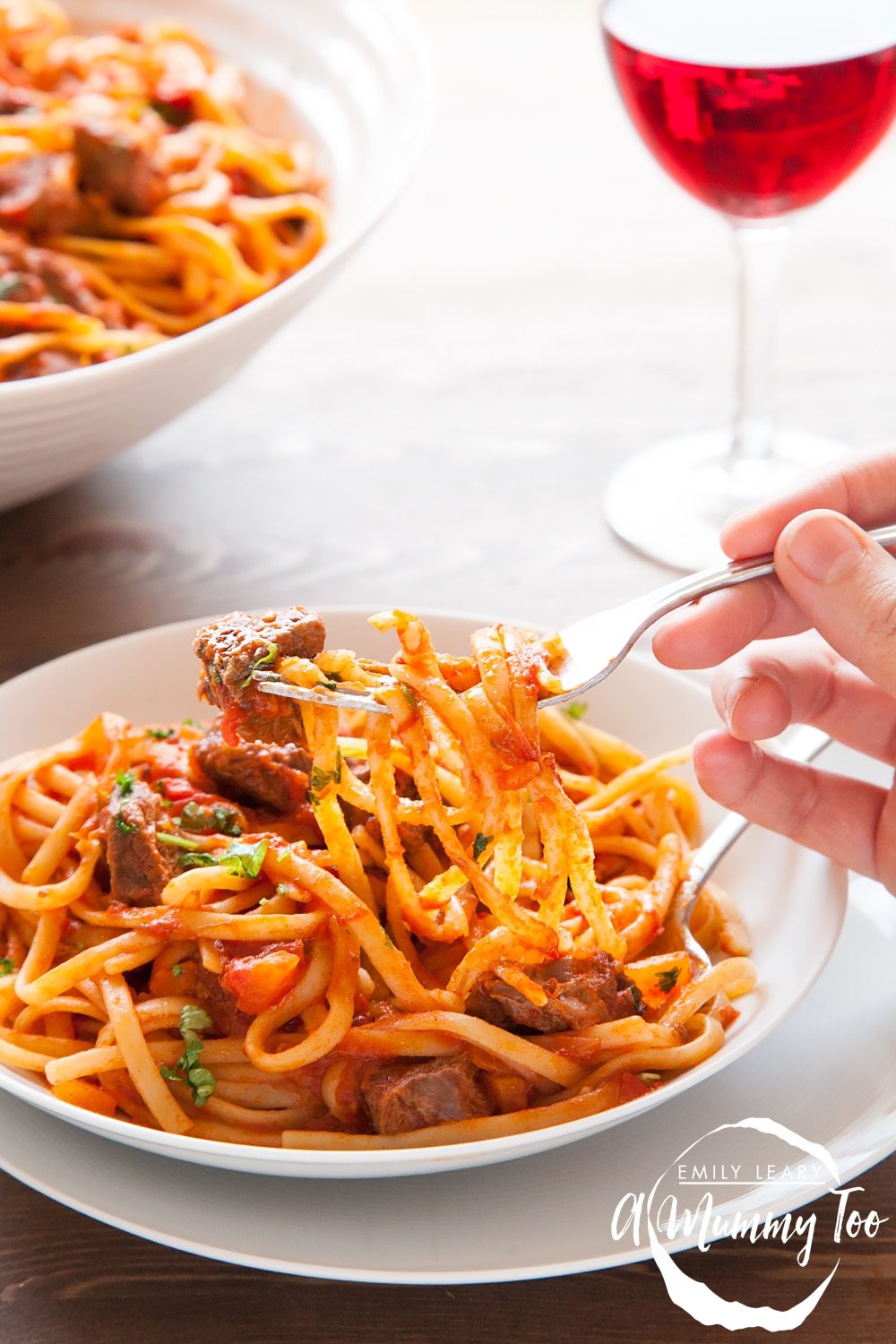
It uses leg and shin cuts of beef, which are cheaper cuts but perfectly good for slow-cooked meals. The tomatoes and herbs cook down over several hours, meaning the meat softens and the flavours intensify as the sauce reduces.
This slow-cooked beef ragu linguine is all minimal fuss and maximum taste. I think you're going to love these hearty bowls.
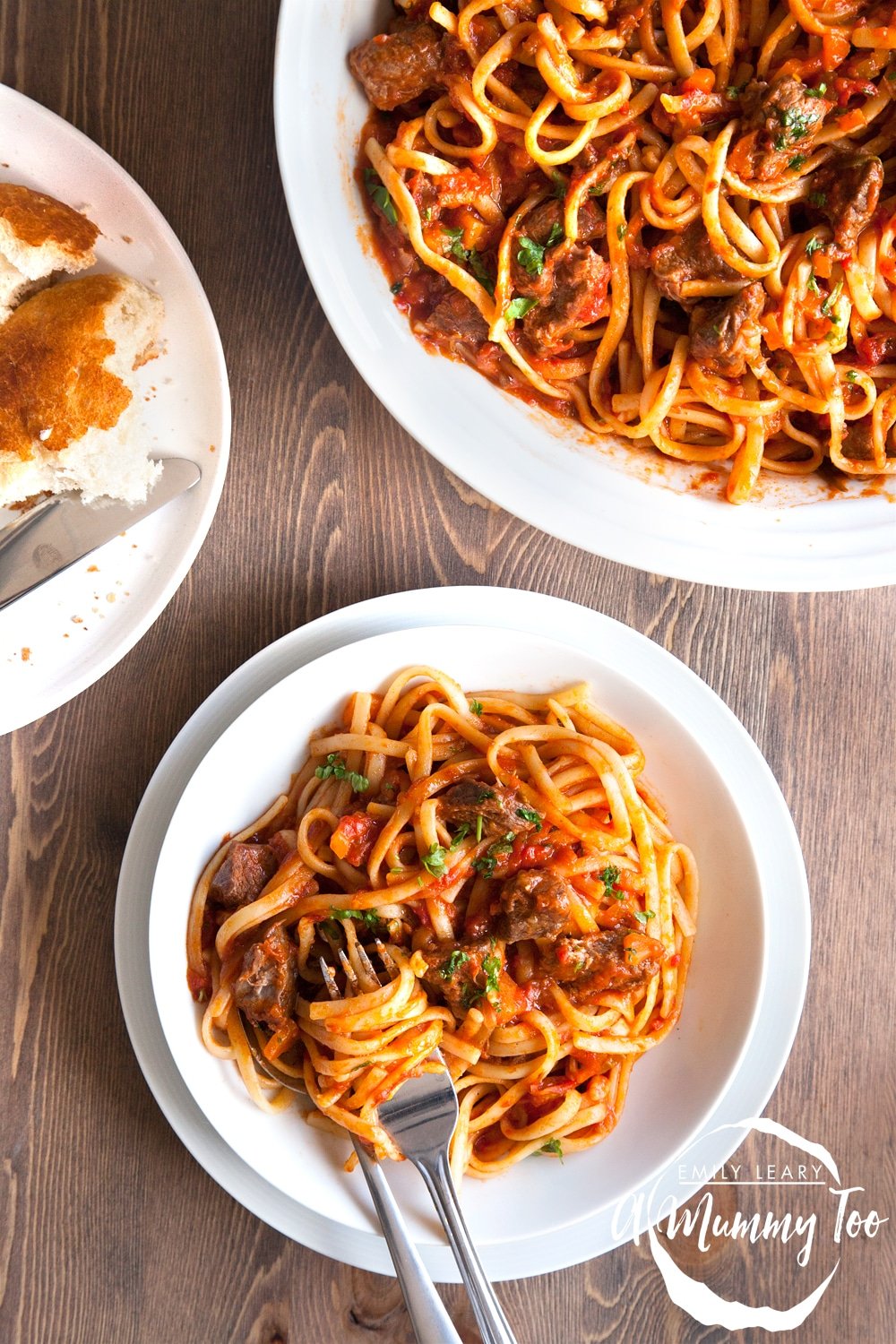
Ingredients
- 1 kg (2.2 lb) beef leg and shin, diced
- 100 ml (3.4 floz) vegetable oil (canola oil)
- 1 onion
- 2 carrots
- 1 stick celery
- 2 cloves garlic
- 1 pinch salt and black pepper
- 1600 g (3.5 lb) canned plum tomatoes
- 2 tbsp tomato puree
- 2 bay leaves
- 3 sprigs rosemary
- 1 litre boiling water
- 2 beef stock (bouillon) cube
- 500 g (1.1 lb) dried linguine
Equipment
Instructions
Warm 2 tbsp of oil in a large, heavy-bottomed saucepan.
When it's hot enough to sizzle, pat the chunks dry with kitchen towel, season with salt and pepper and add to the pan as is, or trim into smaller chunks (see step 8 for an alternative approach).
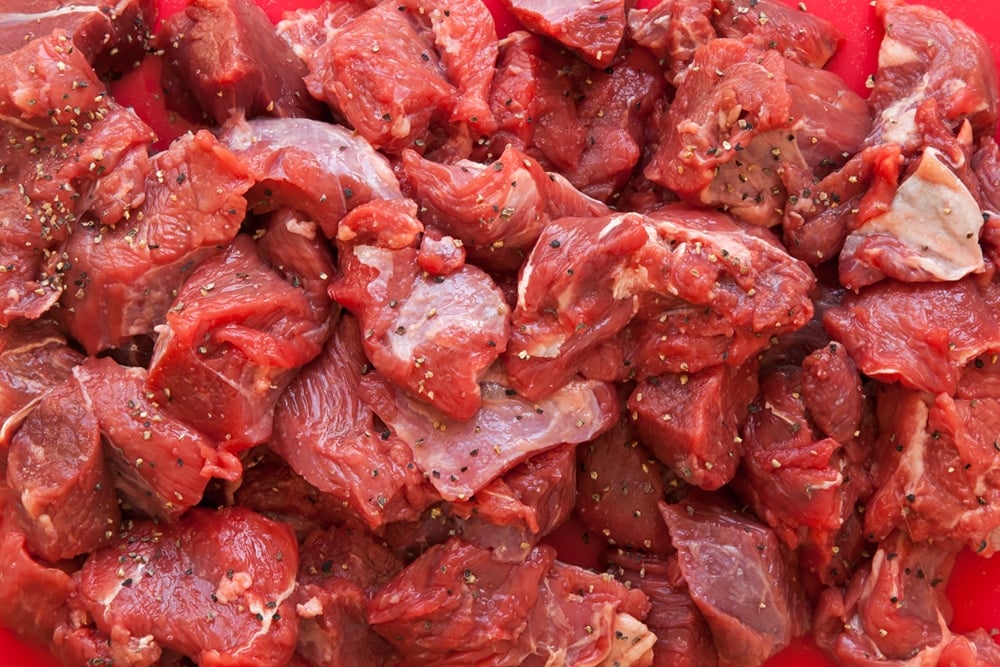
Cook until just seared, then drain and set aside.
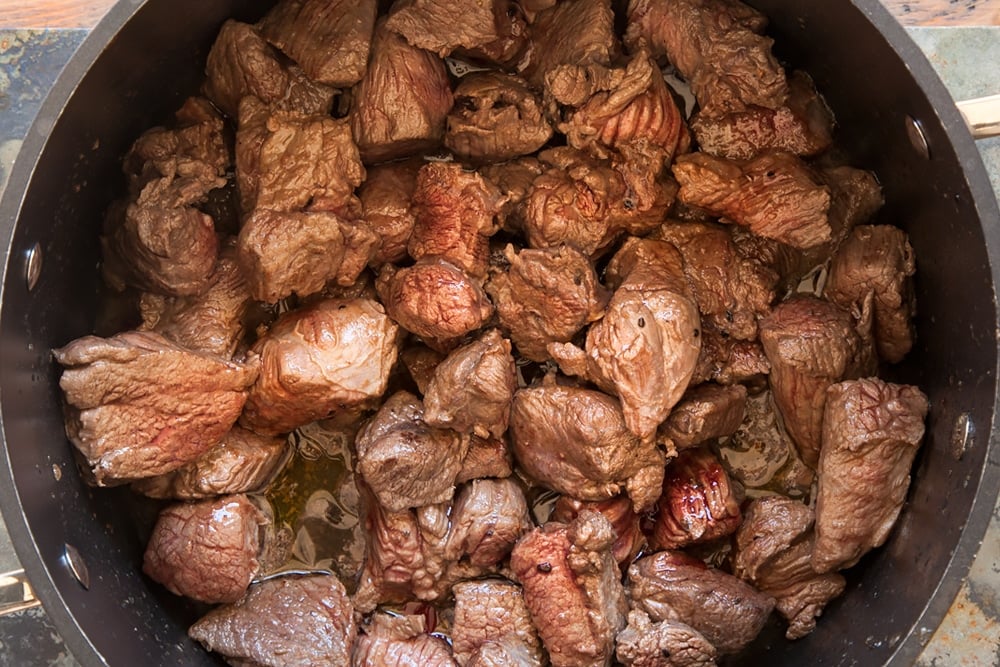
Add 2 tbsp of oil to the pan, turn down the heat.
To make your soffritto, finely chop the onion, carrots, celery and garlic and add to the pan on low, cooking gently with a good pinch of salt and pepper until softened.
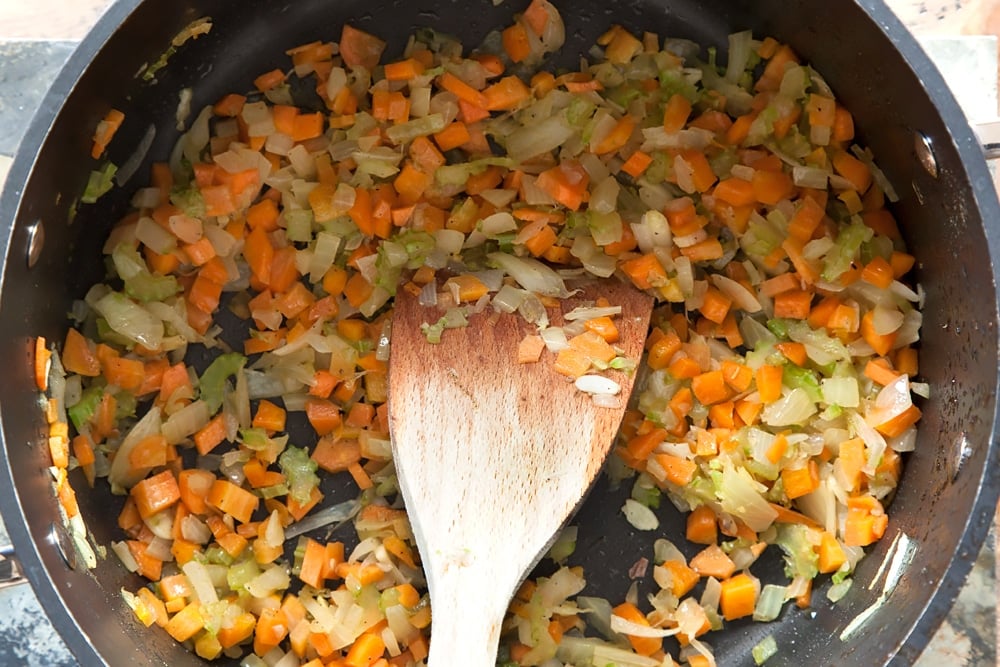
When the soffritto is nice and soft, add the tomatoes, tomato paste, bay leaves rosemary sprigs, boiling water and stock cubes, stir well and bring up to a gentle simmer (don't boil). The turn the heat down as low as it can go and put the lid on the pan.
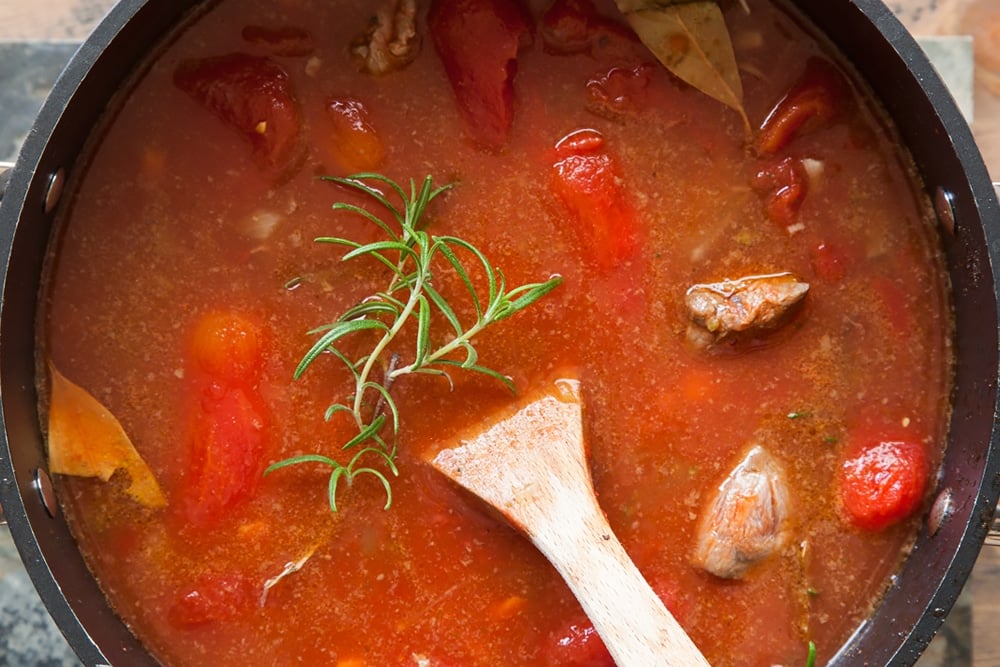
Slow cook for 90 minutes, lifting to stir occasionally and ensure nothing sticks to the bottom of the pan.
Note: at this point, I scooped out the beef chunks with a slotted spoon and roughly chopped them to about quarter of their original size. You could chop them sooner (see step 2), I just find it easier once they're all soft and juicy.
Remove the saucepan lid and slow cook for a further 60 minutes. Your sauce should now be reduced, thicker, as well as being deeper in colour. Season to taste.
Ensure the liquid is simmering, then add the linguine and press it down gently until it's submerged in the pan.
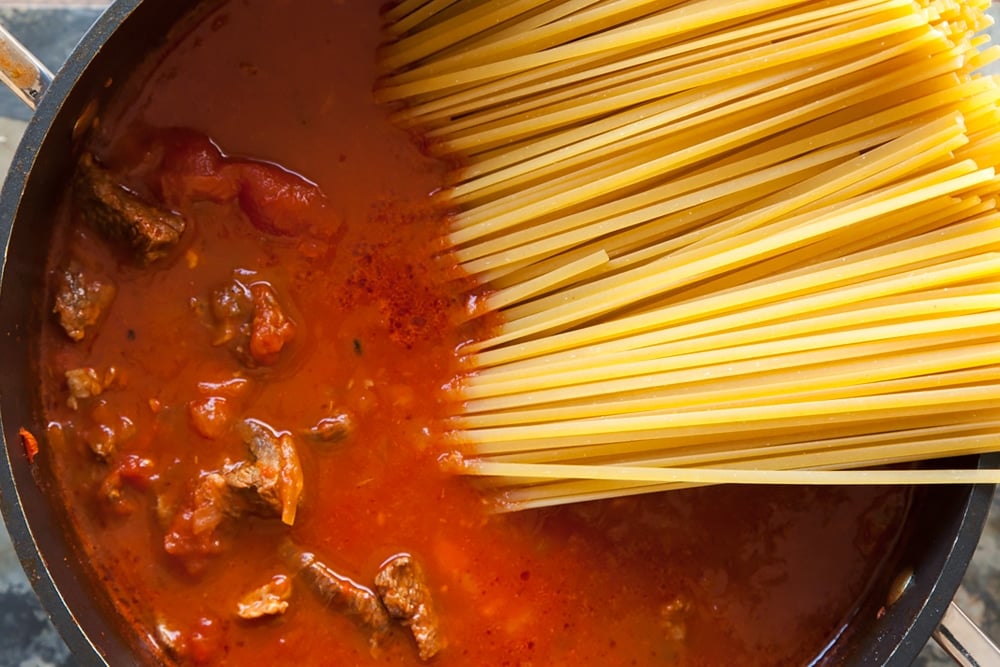
Put the pan lid on, cook for a couple of minutes, then stir the pot (this stops the linguine sticking). Replace the lid for 5 minutes, then cook for the last 5 minutes with the pot uncovered.
Use your judgement, but all in all the pasta should take about 10-12 minutes in total to become al dente at which point the sauce should be thick and clinging to the pasta.
Tip everything into a large serving serving bowl, drizzle with the remaining olive oil and a sprinkle of parsley if desired and bring your slow cooked beef ragu linguine to the table with a serving spoon so that everyone can dig in and help themselves.
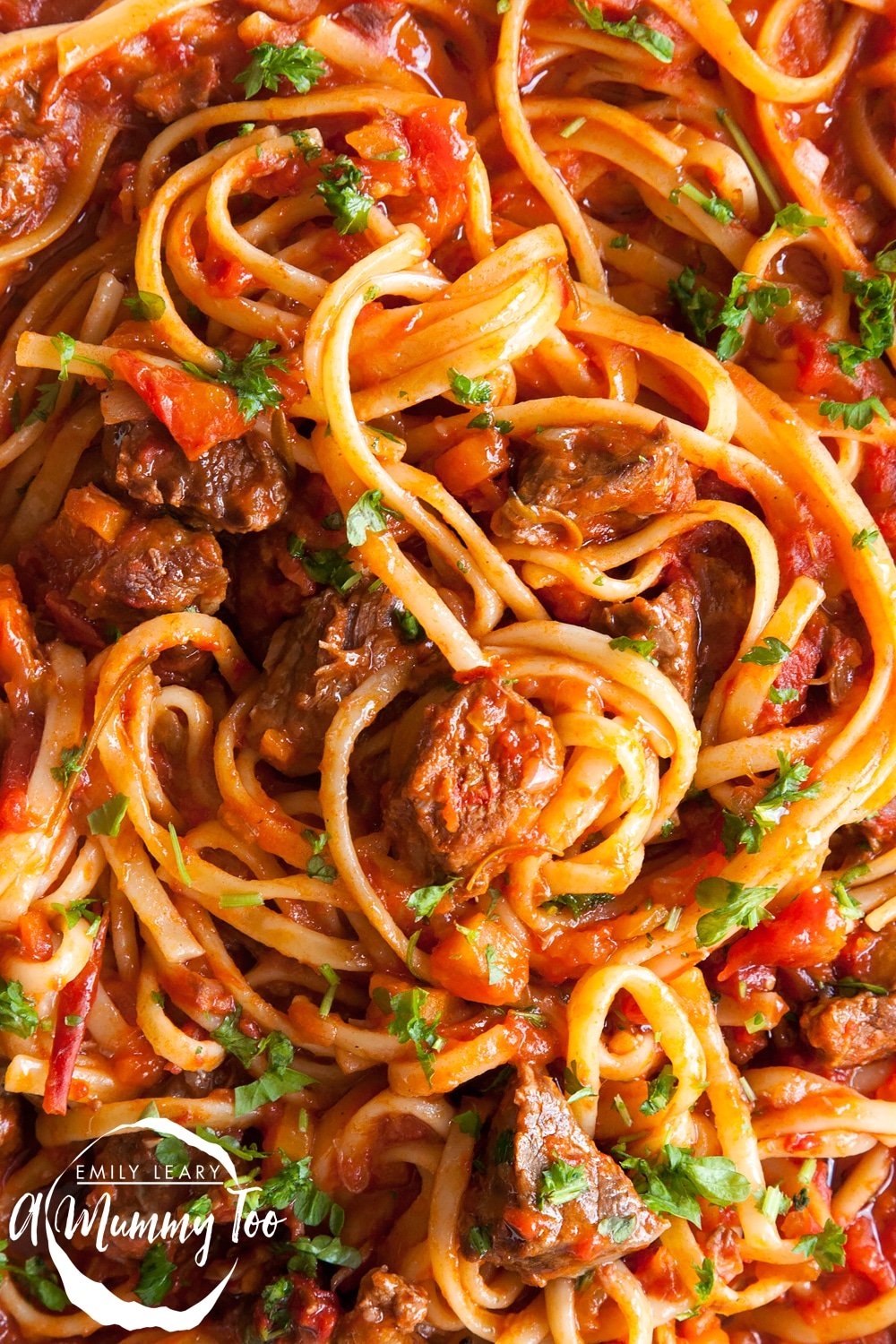
I hope this slow-cooked beef ragu linguine has inspired you to try out your own Live Peasant recipes. Are you tempted to try this recipe at home?
Pointers, tricks and troubleshooting tips for the perfect one-pot slow-cooked beef ragu linguine
Is one-pot slow-cooked beef ragu linguine easy to make?
With a bit of effort at the start to get the ragu going, and again at the end to finish off with the pasta, this is a simple and satisfying one-pot ragu that you’ll want to make time for.
It’s great to make at the weekend when you can leave the pan to simmer and reduce whilst you potter about and get on with other things, keeping an eye on the pan from time to time.
Will I need any special equipment for this one-pot slow-cooked beef ragu with linguine?
Everything you need should be easy to find in most kitchens. To prepare the veggies and beef you’ll need a chopping board and knife.
This recipe makes a lot so you’ll need a big pan, with a lid to cook it all in, if you want to make less, see note below in changing the quantities. The full list of equipment can be found in the recipe card below.
Where can I buy beef leg and shin?
You should be able to find something suitable at the supermarket, or you can ask your butcher and they’ll cut it into chunks for you too. As these cuts of meat come from a part of the animal that has to work quite hard, it can be quite sinewy and chewy if not cooked for long enough. It’s perfect for this recipe because the low, slow cooking time softens the meat making it lovely and tender.
Most supermarkets will have ready diced beef that would also work for this recipe, sometimes it’s called casserole beef when it's already chopped up.
How can I tell if beef has gone off?
The first thing to check is the Use-By date, if you get your meat from a butcher ask them for a Use-By date, and make sure the meat is still within this time. If not, then the beef will no longer be safe to eat and should be discarded. Remember this is different from sell-by dates, which is the date a shop needs to sell a product by, but it will still be ok to eat a few days after this date.
Has the beef been stored correctly? It should be kept in the coldest part of the fridge, make sure the packaging is still intact and not damaged.
Take a look at the beef, it should be dark reddish, if there is a greenish tinge over the surface this may be a sign the beef is starting to go bad. Confusingly, sometimes the meat will become brown, particularly when exposed to light in a store, and this isn't always a sign the beef has gone off. As long as this brown discolouration isn’t combined with any of the other signs, and it is in date, it should still be ok to use.
Fresh beef will have a slight meaty smell, but it shouldn’t be unpleasant or ammonia smelling, a sure sign the beef has gone off is a rancid smell.
Gone off beef might also have a slimy film over the surface, and look shinier than usual.
Is this beef ragu with linguine recipe suitable for vegetarians or vegans?
One of the main ingredients in this recipe is beef, and it also contains beef stock, so if followed as the directions this would not be suitable for vegetarians or vegans.
I haven’t tried making a vegetarian or vegan version of this recipe yet, but you could use aubergine and courgette chunks instead of the beef shin. Lightly fry them in a little oil and set them aside whilst you cook the soffritto. Make sure to use vegetable stock cubes too. Slow-cook until the sauce has thickened, and cook the pasta as per the recipe instructions.
Is this beef ragu with linguine recipe gluten-free?
For this recipe, I’ve used wheat-based linguine so it is not gluten-free. If you want to try and make this recipe gluten-free simply use gluten-free pasta. Make sure to check all other elements are gluten-free as well, particularly the stock cubes as they sometimes contain wheat.
When cooking for someone who needs to avoid gluten it’s also important to check anything else you might be serving with your pasta is gluten-free too.
Is beef ragu with linguine safe to eat while pregnant?
There is nothing in this recipe that would usually pose a risk to a pregnant woman, as long as all the ingredients are in good condition, and the ragu is prepared and cooked hygienically.
If you have any questions or concerns please speak to a health professional, A Mummy Too does not offer medical advice.
What goes well with this beef ragu with linguine?
This one-pot ragu is a hearty meal all in one, if you’re serving this for a big family dinner why not serve it with some bright and peppery rocket salad.
Chop a few handfuls of cherry tomatoes in half, and throw in some black olives, toss the salad with a little olive oil and seasoning, and add a few shavings of parmesan on top if you have some for a final flourish.
Can I make this beef ragu linguine without celery?
The celery makes up part of the soffritto, the aromatic base for ragu sauce, as well as lots of other Italian and Medetareain dishes.
If you need to avoid celery you can of course leave it out. Add in another half an onion or a bit of extra carrot if you like. Make sure to check the stock cubes don’t contain celery as some do.
I haven’t got plum tomatoes, can I use chopped tomatoes?
I prefer to use plum tomatoes for this recipe as it is cooked for such a long time the whole tomatoes cook better and will eventually break down to create the beautiful rich sauce.
I also find the juice with plum tomatoes seems a little thicker, but that might just be me.
All that said, this recipe will of course work with chopped tomatoes as well, or you could use a mixture of both if you like.
Can I add extra veggies to this recipe?
As this makes enough for eight servings you might not have enough space in the pan for more veggies!
If you do, you could finely chop a courgette and add it to the soffritto, or add in larger chunks of courgette or peppers once the soffritto has cooked, and you're adding all the other ingredients in. You can of course serve extra veg on the side in a lovely salad.
How should I store beef ragu with linguine?
Any leftovers need to be cooled and put away as quickly as possible, no longer than 2 hours after cooking.
Divide leftovers into portions in suitable containers, they will cool down quicker this way. Once cool, store in the fridge, or freezer depending on when you want to use up your leftovers.
How long does beef ragu with linguine keep?
When stored correctly this recipe will keep for up to 3 days in the fridge, and if frozen on the day of cooking it will keep in the freezer for up to 2 months.
Can I leave beef ragu with linguine out on the counter?
No, other than for serving and when you’re cooling any leftovers. This ragu can not be left out on the counter as this will increase the risk of foodborne illnesses spread in the food, making it no longer safe to eat.
Can I make beef ragu with linguine ahead?
Yes, you can make this recipe ahead. You have a few options depending on how much you want to make and when you want to cook the pasta.
The recipe as it is serves 8, so we’re a family of 4, and then automatically have 4 portions leftover which you can store in the freezer for up to 2 months.
I cook the pasta al dente so it still has some bite, when you come to reheat any leftovers or if you have made ahead linguine ragu, the pasta will continue to cook, becoming softer.
If you prefer you can make just the ragu sauce ahead, and cool and store it before the pasta has been added. Then add the pasta when you reheat the sauce, this way ensuring al dente pasta.
Another time saver some people like to do is make a bigger batch of the soffritto base which can save time when cooking if you’re making a few similar recipes. With this method do keep in mind you can only really reheat food once after the initial cooking. So if you’ve made soffritto ahead, and added it to your ragu, the ragu would then need to be eaten up in one sitting as it contains soffritto that has already been cooked, cooled, and heated up again.
Can I keep beef ragu with linguine in the refrigerator?
Yes, any leftovers need to be cooled and put into the fridge within 2 hours of cooking, as soon as you can really. Pop your ragu into suitable containers or bowls that you can cover. It will keep in the fridge for up to 3 days.
Can I freeze beef ragu with linguine?
This is a great meal to freeze, all that time spent simmering the rich sauce can be saved for another day when you want something quick and easy.
You need to freeze this on the day of making so divide any leftovers into freezer containers. I recommend splitting it into portions so you can just get out what you need.
You can of course freeze some of the ragu sauce before you add the pasta if you prefer to cook the pasta fresh.
Label your containers with the date, and what's inside! This ragu will keep in the freezer for up to 2 months. Defrost in the fridge overnight, or using the defrost setting on the microwave. Once thawed consume within 24 hours.
What is the best way to reheat beef ragu with linguine?
You can either reheat this ragu in the microwave, or on the hob. If you’ve got a lot to reheat it might be quicker to do it all in a pan together on the stove.
To microwave, put a portion of ragu onto a microwave-safe bowl or plate, loosely cover, and heat for 2-4 minutes on full, stirring halfway through. Repeat for all portions, making sure the food is piping hot before serving.
To heat on the hob, put all the ragu into a suitable sized pan with a lid, you may need to add a splash of water if the sauce starts to stick. Heat over a medium heat, stirring regularly until all the ragu is piping hot.
Can I make beef ragu with linguine in a different quantity?
The recipe is currently set to make 8 portions, I like to make double as this recipe does take a long time to reduce and cook, it's a great one to have in the freezer ready for a busy night when there’s no time to cook from scratch.
You can of course change the amounts on the recipe card if you want to make less, or even more of this yummy ragu. Head down to the recipe card below and you’ll see the number of servings is set to 8. Click or hover this number and a little slider will appear that you can move up or down to get the number you want to make. All the ingredients will update automatically for you so no need to do any working out.
Can I make beef ragu with linguine in individual portions?
This is definitely one of those recipes that is easier made altogether in one big pan. By all means, serve into separate individual bowls in the kitchen rather than a big serving dish on the table for people to help themselves.
Can I make beef ragu with linguine with a food processor?
If you want to save a bit of time prepping the veg for the soffritto you can use a food processor.
Roughly chop the carrot, celery, onion, and garlic into chunks and pop them into the food processor, pulse until you have finely chopped veg. Make sure to use the pulse mode, whizzing for a few seconds at a time so you can stop before you end up with vegetable paste!
Depending on the size of your food processor you may need to do this in a few batches, but it's centrally quicker than finely chopping everything by hand.
Can I make beef ragu with linguine in the slow cooker?
I haven’t tested this recipe in a slow cooker yet, but it's the kind of recipe that could be ideal for this if your slow cooker is big enough to hold all the ingredients.
Sear the meat on the hob, and set it aside whilst you cook the soffritto, add everything into the slow cooker, and follow your particular model instructions as a guide for temperature and time settings. Add the pasta in at the end, as per the recipe, and cook until al dente.
Can I make beef ragu with linguine in the instant pot?
An instant pot could be a great way to get the cooking time down a bit if you have one. I haven’t tried this recipe in an instant pot yet, so do let me know how you get on in the comments below.
I would suggest still searing the meat on the hob and cooking the soffritto before adding everything else into the pot. Check your instructions for a guide to the correct settings for your instant pot.
How can I make sure this beef ragu with linguine is perfectly cooked?
Time is the main thing with this recipe, the longer the sauce has to simmer the richer it will be, and the more tender the beef will become. So make sure you have plenty of time to let the pan simmer and work its magic.
Searing the meat is important to seal the outsides and lock in some of the moisture. And taking the time to let the soffritto soften and the flavours develop is key before adding the tomatoes and other ingredients. You’ll know the sauce is ready when it’s reduced and thickened up into a lovely rich red ragu.
Why did my ragu stick to the pan and burn?
It’s important to turn the hob down to the lowest setting when slow cooking the ragu. If you have a gas hob using a heat spreader can be helpful to make the heat on the bottom of the pan slightly less intense.
Make sure you keep checking on the pan throughout the 90 minutes simmering time. These moments of stirring make sure everything is moving around the pan, and it's not the same bit right at the bottom.
If the sauce is starting to stick a little stir more regularly. If the sauce has really stuck to the bottom badly don’t try and scrape it off into the sauce as this might make the whole ragu taste burnt.
If this happens, you can transfer the ragu into a clean pan, leaving the burnt bottom in the original pan. This way you can continue to reduce and cook the ragu without it being spoilt with the burnt bottom. Put some hot soapy water into the bottom of the burnt pan to help soak it off. Using a heavy bottom pan will also help regulate the temperature.
Why did my ragu turn out really wet?
In total the sauce will be cooking and simmering for two and a half hours or more, so this should be plenty of time for the ragu to reduce beautifully.
Make sure the pan is actually simmering, it should be gently popping bubbles on the surface occasionally. Otherwise, the ragu isn’t hot enough to cook properly and the sauce won't reduce.
After the first 90 minutes with the lid on, you need to remove the lid to let some of the steam escape, if you put the lid back on for the last hour of cooking this may be why your sauce is quite wet. The pasta should help absorb some of the excess water.
Why did my ragu taste bland?
This slow-cooked ragu shouldn’t taste bland as it has had so long for all the flavours to develop into the intense red sauce.
As long as this isn’t being served to young children you can season with salt to help lift the flavours. Next time, perhaps add a few more cloves of garlic if you like a stronger taste.
How can I add/change the flavours in this dish?
You can play around with this recipe depending on what you have in the fridge, you could try adding extra veggies like chunks of pepper and courgette. I find aubergine works beautifully in slow-cooked recipes too. Lightly fry chunks of aubergine, a bit like searing the meat and set them aside, add to the pan when you put in the plum tomatoes.
You can also mix things up with the meat, try substituting some of the beef for sausage meat, cook the sausage meat after you’ve seared the beef, and set aside until you’re ready to add it to the pan with the beef.
Print this slow-cooked beef ragu linguine recipe
One Pot Slow-Cooked Beef Ragu Linguine Recipe
Ingredients
- 1 kg (2.2 lb) beef leg and shin, diced
- 100 ml (3.4 floz) vegetable oil (canola oil)
- 1 onion
- 2 carrots
- 1 stick celery
- 2 cloves garlic
- 1 pinch salt and black pepper
- 1600 g (3.5 lb) canned plum tomatoes
- 2 tbsp tomato puree
- 2 bay leaves
- 3 sprigs rosemary
- 1 litre boiling water
- 2 beef stock (bouillon) cube
- 500 g (1.1 lb) dried linguine
Instructions
- Warm 2 tbsp of oil in a large, heavy bottomed saucepan.
- When it's hot enough to sizzle, pat the chunks dry with kitchen towel and add to the pan as is, or trim into smaller chunks (see step 8 for alternative approach).
- Cook until just seared, then drain and set aside.
- Add 2 tbsp of oil to the pan, turn down the heat.
- To make your soffritto, finely chop the onion, carrots, celery and garlic and add to the pan on low, cooking gently with a good pinch of salt and pepper until softened.
- When the soffritto is nice and soft, add the tomatoes, tomato paste, bay leaves rosemary sprigs, boiling water and stock cubes, stir well and bring up to a gentle simmer (don't boil). The turn the heat down as low as it can go and put the lid on the pan.
- Slow cook for 90 minutes, lifting to stir occasionally and ensure nothing sticks to the bottom of the pan.
- Note: at this point, I scooped out the beef chunks with a slotted spoon and roughly chopped them to about quarter of their original size. You could chop them sooner (see step 2), I just find it easier once they're all soft and juicy.
- Remove the saucepan lid and slow cook for a further 60 minutes. Your sauce should now be reduced, thicker, as well as being deeper in colour.
- Ensure the liquid is simmering, then add the linguine and press it down gently until it's submerged in the pan.
- Put the pan lid on, cook for a couple of minutes, then stir the pot (this stops the linguine sticking). Replace the lid for 5 minutes, then cook for the last 5 minutes with the pot uncovered.
- Use your judgement, but all in all the pasta should take about 10-12 minutes in total to become al dente at which point the sauce should be thick and clinging to the pasta.
- Tip everything into a large serving serving bowl, drizzle with the remaining olive oil and a sprinkle of parsley if desired and bring to the table with a serving spoon so that everyone can dig in and help themselves.
Video
Nutrition
Pin this slow-cooked ragu recipe
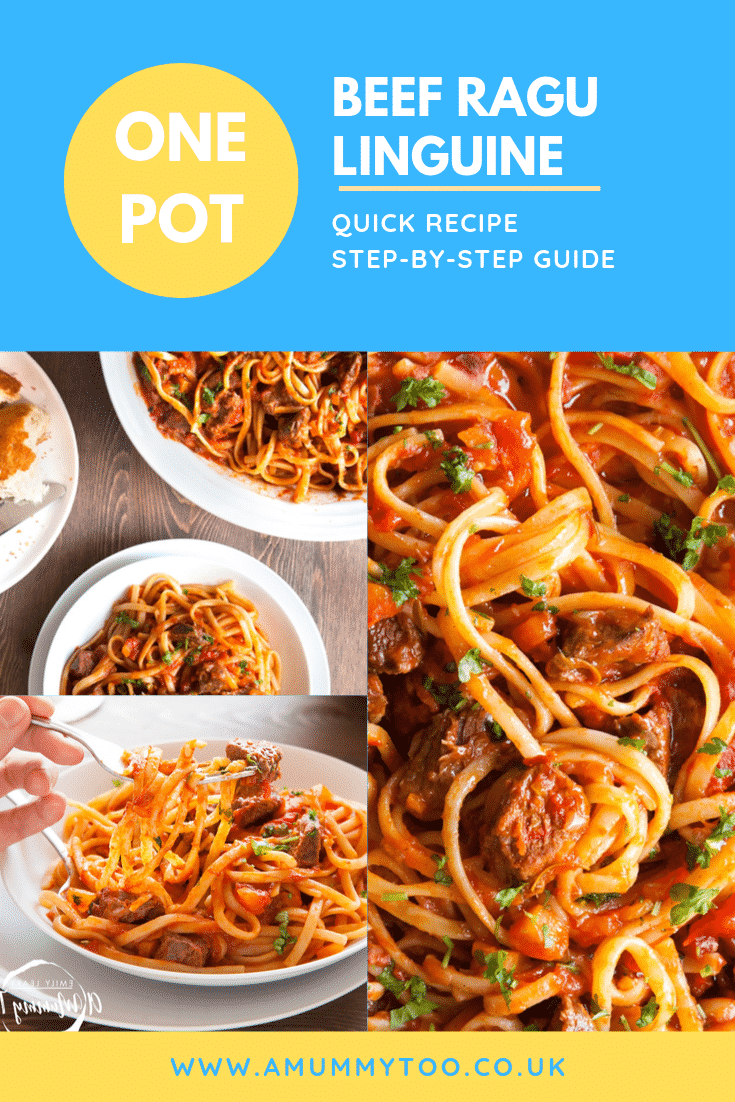
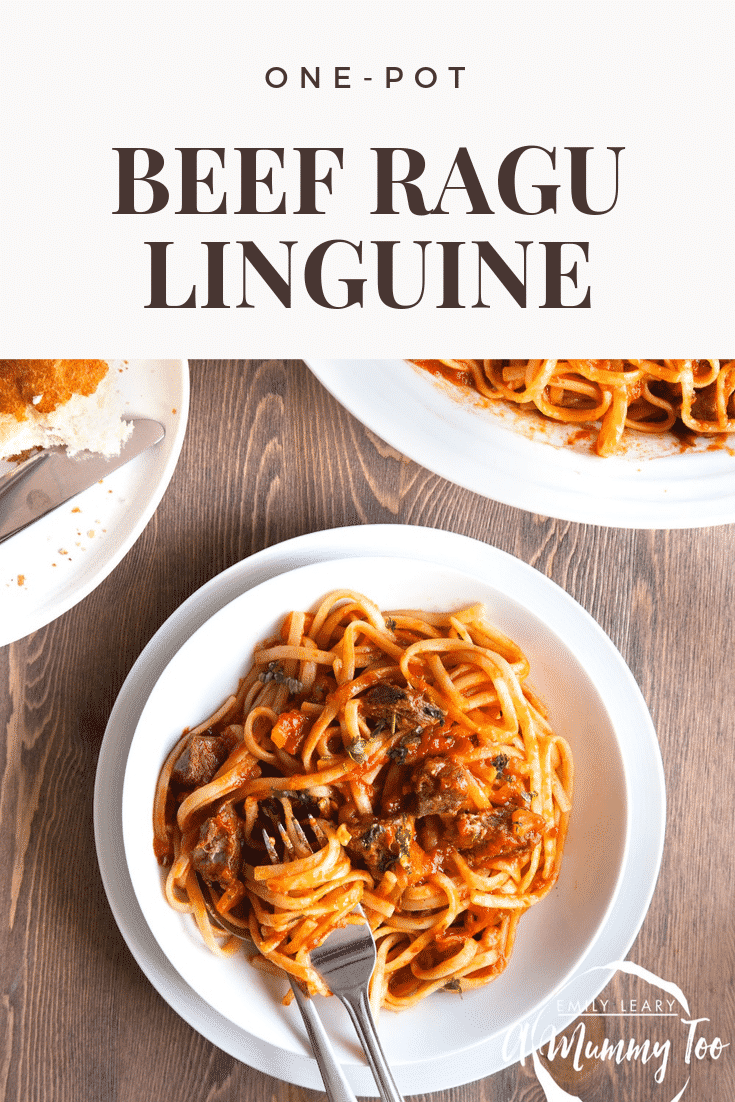
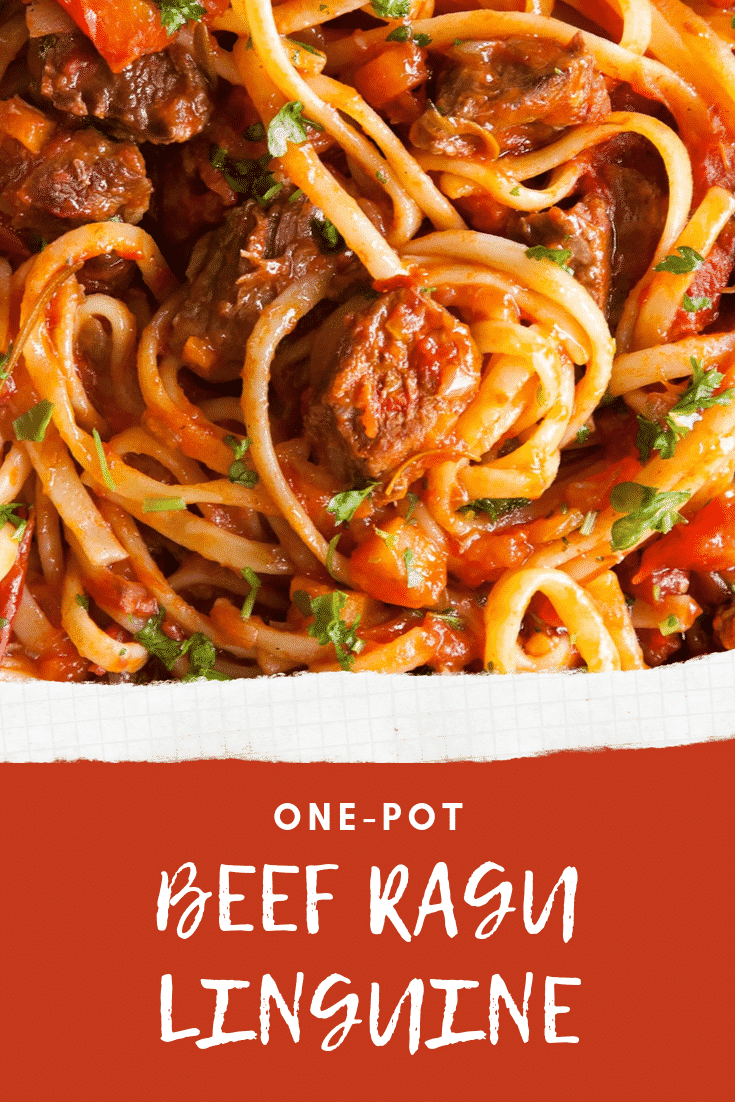
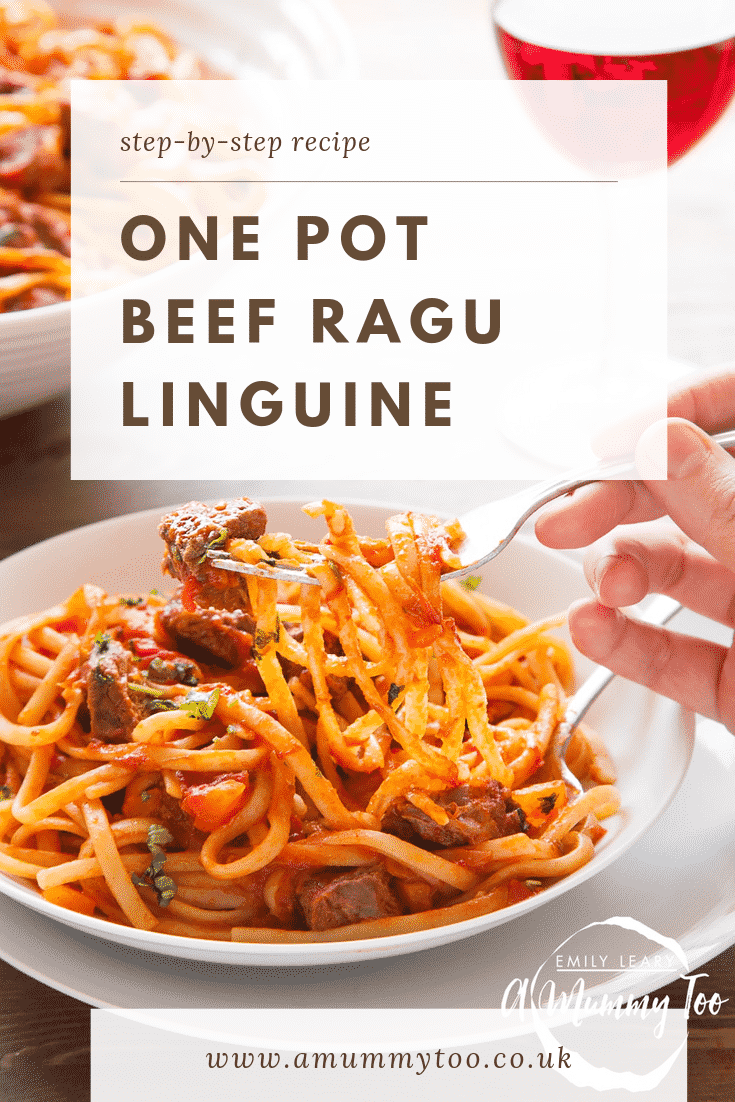
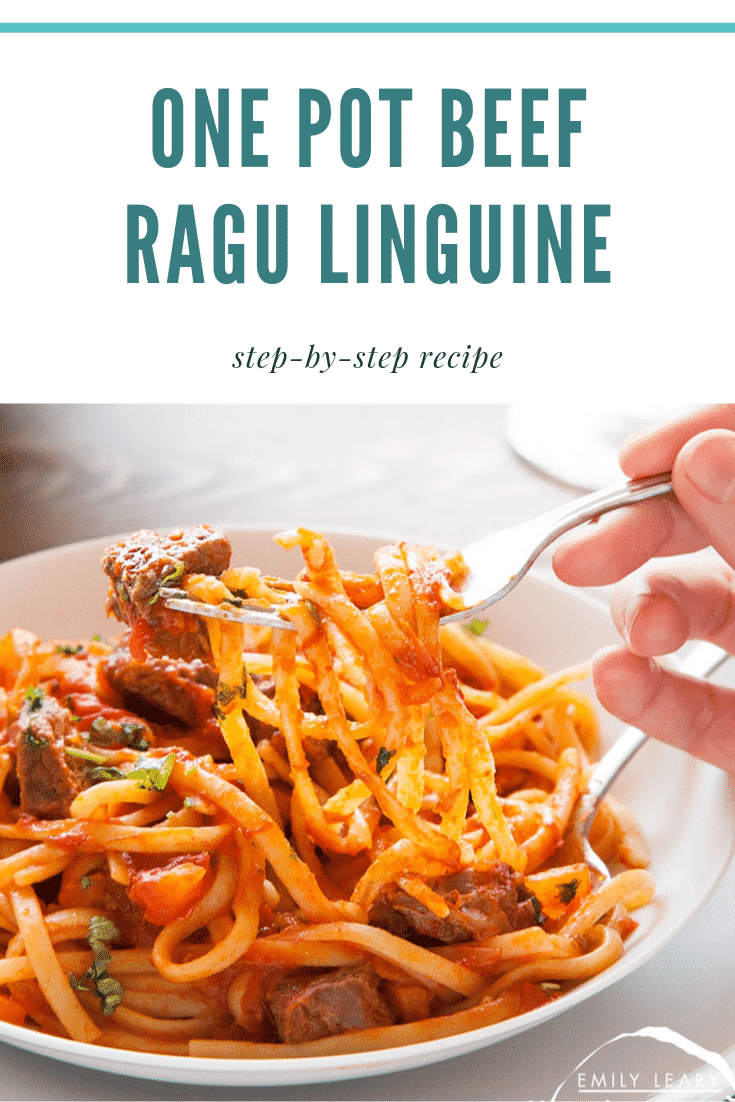
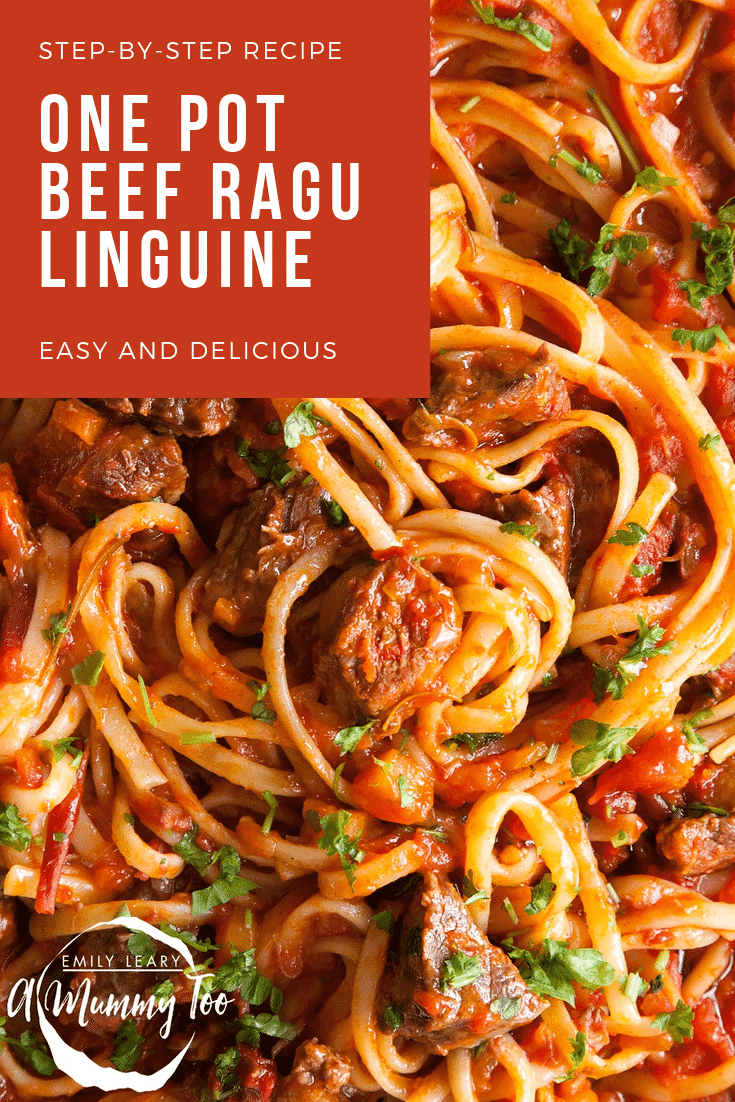
More delicious slow cooker ideas
Have you got my book?

'This is a great kids cookery book. Emily is a star' - Simon Rimmer
'The book I'd like to force into any mother's kitchen' - Prue Leith
"A fab book with a plan." - Jane Devonshire, 2016 Masterchef UK winner
'Emily has managed to combine her mummy knowledge and passion for food to make a truly helpful and brilliant cookbook' - Priya Tew, RD, BSc (Hons), Msc
Get Your Kids to Eat Anything is an achievable 'how to' for parents in the battle to overcome picky eating and 'make new the norm'. Emily Leary's unique 5-phase programme looks at the issue of 'fussy eating' in a holistic way that links imagination with food, and which situates parents alongside - not in opposition to - their children.


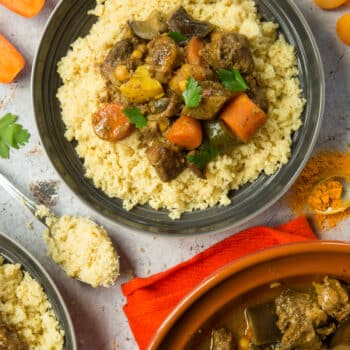

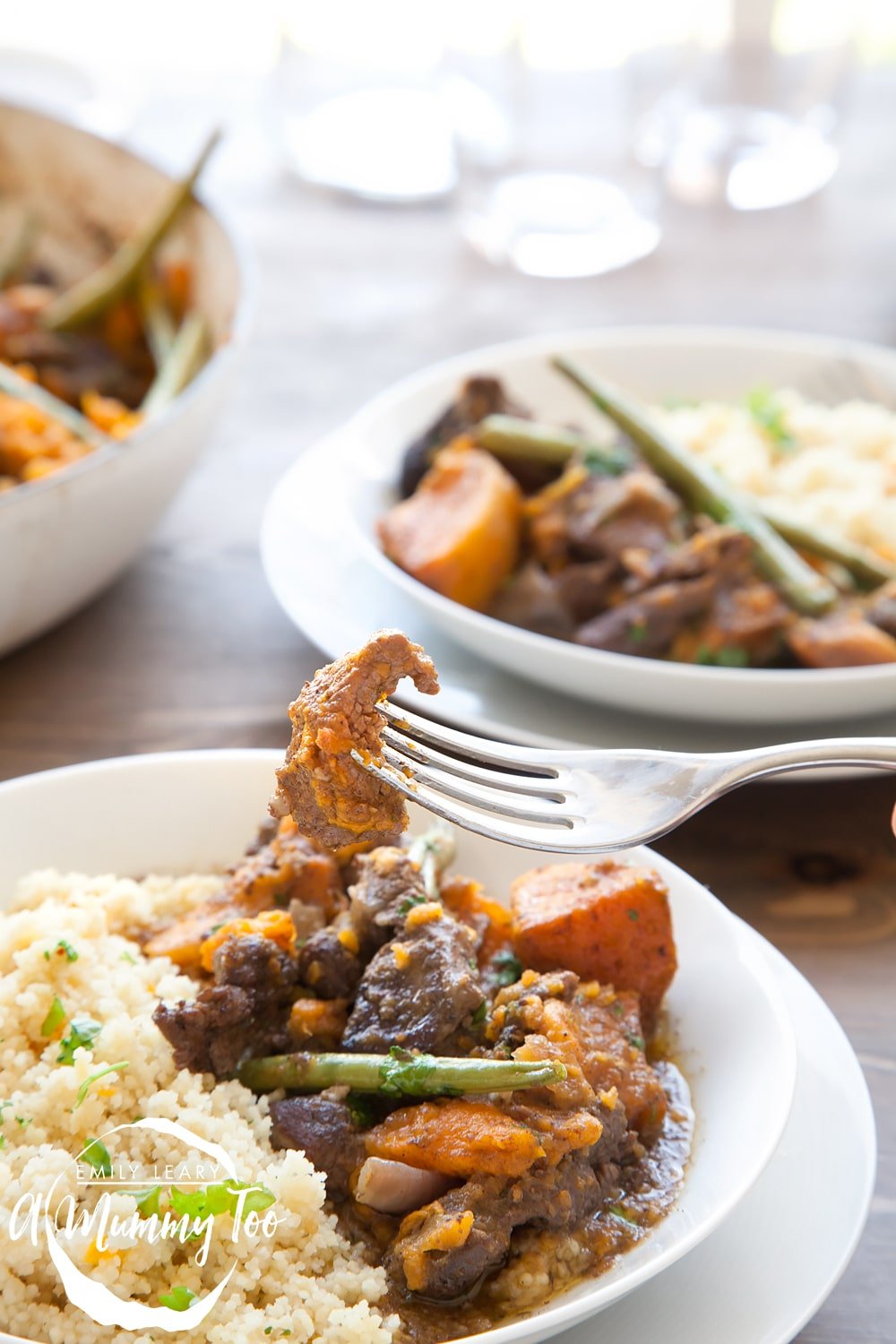

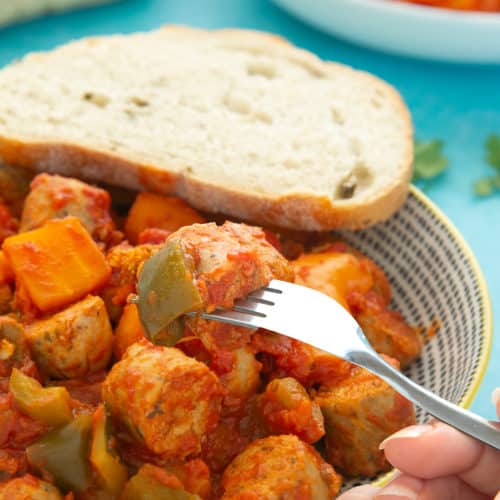
jenny paulin says
this looks delicious
Charlie @ The Kitchen Shed says
Wow, this looks delicious! And even better as a one pot meal, genius!